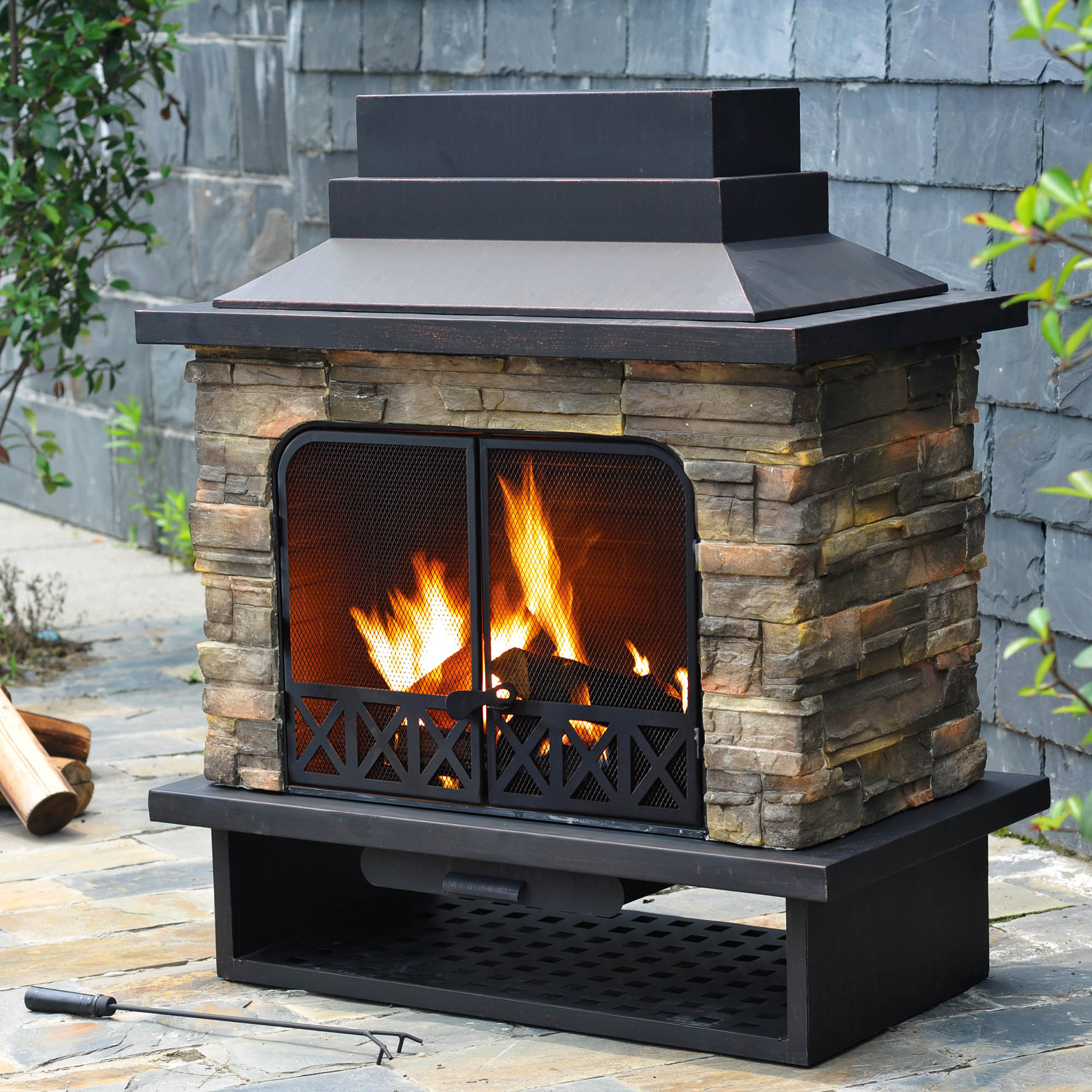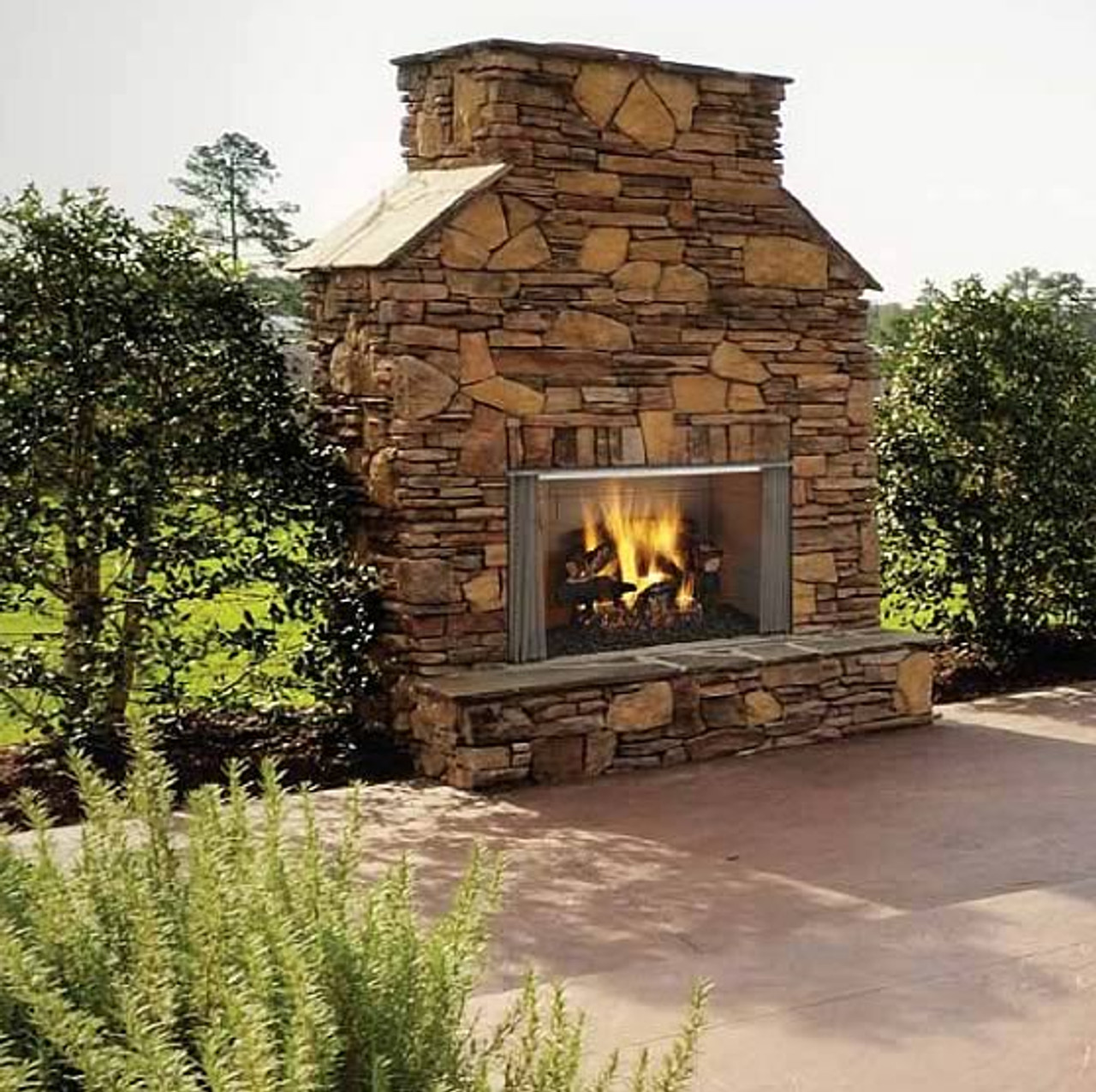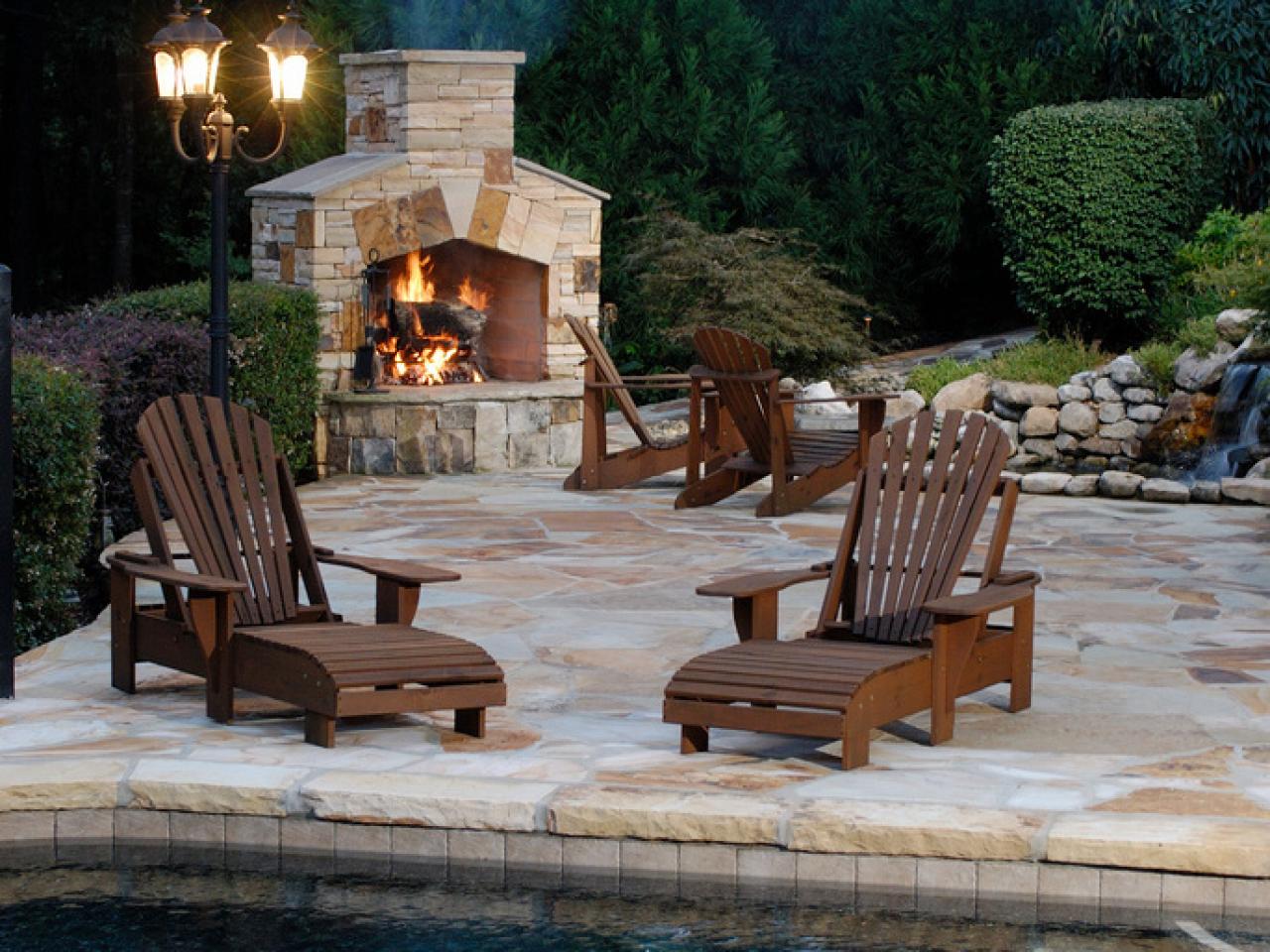Outdoor Wood Fireplace
An outdoor wood fireplace can be a stunning addition to any backyard, creating a warm gathering space and adding an elegant ambiance to outdoor spaces. Whether you’re looking to enjoy cozy evenings under the stars, host gatherings, or simply add value to your property, an outdoor wood fireplace can make all the difference. Let’s discuss the essentials of outdoor wood fireplaces, from design and installation to maintenance and safety, providing insights into creating a safe, functional, and beautiful outdoor hearth.

Benefits of an Outdoor Wood Fireplace
An outdoor wood fireplace offers a unique atmosphere that elevates any backyard experience. Unlike gas or electric options, a wood-burning fireplace provides the crackling sound of natural wood and a pleasant smoky aroma that adds to the ambiance. The natural flame of a wood fire is visually captivating, offering a relaxing environment perfect for unwinding alone or sharing memorable moments with family and friends.
Wood-burning fireplaces are also an energy-efficient heating source, allowing you to enjoy your outdoor space even in cooler weather. Unlike propane or electric heaters, wood is often more affordable, especially if you have access to your supply. This makes wood fireplaces an economical choice for homeowners who want to extend the usability of their outdoor space through the colder months without incurring high heating costs.
In addition to creating warmth and ambiance, an outdoor wood fireplace can boost your property’s aesthetic and market value. A well-designed fireplace becomes an architectural focal point that enhances landscaping and outdoor living areas. This attractive feature is highly appealing to potential buyers and can increase the overall resale value of the property, making it a worthwhile investment for both personal enjoyment and long-term property appreciation.

Choosing the Right Location for Your Fireplace
Selecting an appropriate location is one of the most crucial steps in setting up an outdoor wood fireplace. It’s important to choose a site that complies with local codes, which often require a certain distance between fireplaces and structures or property lines. Placing the fireplace away from low-hanging branches, nearby buildings, or overhanging structures is essential to prevent accidental fire hazards.
An outdoor fireplace should also be positioned to maximize its functionality. Ideally, it should be placed where it can effectively provide warmth to seating areas while allowing plenty of room for guests to gather comfortably. The location should also take wind direction into account to ensure that smoke won’t blow directly into seating areas or neighboring properties. A sheltered spot that isn’t too windy can help maintain an even flame and keep smoke away from guests.
Consider the surrounding landscape and pathways when choosing a location. It’s often beneficial to integrate the fireplace into an existing patio or create a designated gathering area around it. Ensuring the ground around the fireplace is level and made from fire-resistant materials, like stone or concrete, can help prevent accidental fires and make the fireplace both safe and accessible. Choosing the right spot sets the stage for a functional and visually appealing outdoor fireplace.

Design Options for Outdoor Wood Fireplaces
The design of your outdoor wood fireplace can greatly influence the aesthetic and function of your backyard. Outdoor fireplaces come in various styles, including traditional, rustic, and contemporary, allowing you to choose a look that complements your existing landscape and home architecture. Brick, stone, and concrete are popular materials for outdoor fireplaces, as they are durable, heat-resistant, and visually appealing.
Traditional fireplaces often feature a classic, symmetrical design with materials like brick or natural stone. These designs work well in homes with a rustic or traditional aesthetic, creating a timeless look that blends seamlessly into natural surroundings. For a more modern feel, homeowners may opt for sleek concrete fireplaces with minimalist lines or built-in seating, which adds a chic touch to contemporary spaces.
In addition to the structural design, consider decorative elements like mantels, hearths, and chimneys. A well-designed chimney can help direct smoke away from the seating area, enhancing comfort. Mantels can provide a place to display outdoor-friendly decor items, while a hearth can double as extra seating or a surface for warming food or drinks. Each design element can help customize your fireplace to meet your functional needs and reflect your personal style.

Building and Installation Considerations
Building an outdoor wood fireplace is a complex process that may require professional help, especially if you’re looking for a custom-built structure. It’s crucial to obtain any necessary permits and follow local building codes, which may dictate the size, materials, and location of the fireplace. Hiring a qualified contractor can help ensure compliance with regulations and avoid costly mistakes.
The foundation of the fireplace is essential for long-term stability and safety. A level, fireproof base made from concrete or stone is ideal, as it can withstand the weight and heat of the fireplace structure. A solid foundation also prevents the fireplace from shifting or settling over time, which could lead to structural damage or increased fire risks. Most installations also include a metal firebox, which contains the fire and directs heat outward, improving efficiency and safety.
Installing a chimney or flue is another important step in the process, as it helps manage smoke and keeps it away from the seating area. A properly designed chimney also enhances the draft, which aids in efficient burning. Additional features, such as spark arrestors, can reduce the risk of embers escaping and landing on flammable surfaces. Taking these installation factors into account will ensure that your outdoor fireplace is safe, efficient, and durable.

Safety Precautions for Outdoor Wood Fireplaces
Safety is paramount when operating an outdoor wood fireplace, especially in residential areas. One of the most basic safety measures is ensuring that the fireplace is surrounded by fire-resistant materials, such as a stone or concrete pad, to contain any stray embers. Avoid placing flammable materials, including wooden furniture and cushions, near the fireplace to minimize fire risks.
Regularly checking and maintaining the fireplace is essential to keeping it safe. Inspecting for cracks or damaged parts can prevent structural hazards while cleaning the firebox and chimney reduces the buildup of creosote, a highly flammable byproduct of burning wood. Additionally, homeowners should store firewood at a safe distance from the fireplace to prevent accidental ignition.
Finally, having fire extinguishing equipment nearby, such as a fire extinguisher, fire blanket, or a bucket of sand, provides a quick response option in case of emergency. When using the fireplace, avoid leaving it unattended and ensure that the fire is fully extinguished before leaving the area. By following these safety precautions, you can enjoy your outdoor fireplace responsibly and with peace of mind.

Maintenance and Seasonal Care
Proper maintenance of an outdoor wood fireplace is necessary to keep it functioning safely and efficiently for years to come. Routine cleaning of the firebox and removal of ash buildup will help improve airflow and burn efficiency. Using tools like a fireplace shovel and brush, homeowners should regularly remove excess ash and debris to keep the fireplace clean and ready for use.
Seasonal maintenance is particularly important for wood-burning fireplaces. In colder months, it may be beneficial to cover the fireplace when not in use to protect it from moisture and weather damage. Rain and snow can accelerate the deterioration of materials, especially if they infiltrate small cracks, which can worsen over time. A waterproof cover designed for outdoor fireplaces can help preserve its structure and prevent unnecessary wear.
At least once a year, a professional inspection is recommended to identify any structural or maintenance issues. A certified chimney sweep can clean the flue and chimney to prevent creosote buildup, which is essential for safe operation. Checking for and repairing cracks, rust, or damage from the elements will ensure that your fireplace remains functional and beautiful. With regular care, an outdoor wood fireplace can provide warmth and enjoyment for many years.

25 Warm and Welcoming Outdoor Fireplaces
/NordbyDesign-5a1ca4bb494ec9003703ca6c.jpg)
Outdoor Brick Fireplace with Wood Mantle Outdoor fireplace brick, Backyard fireplace, Diy

Sunjoy Seneca 51 in. Wood Burning Outdoor Fireplace

Sunjoy Brownston Steel Wood Outdoor Fireplace & Reviews Wayfair

Sunjoy Amherst 35 in. Wood-Burning Outdoor Fireplace-L-OF082PST-3 – The Home Depot

Sunjoy Black Steel Outdoor Wood-Burning Fireplace at Lowes.com

Related Posts:
- Outdoor Fireplace Small Yard
- Pre Made Outdoor Fireplace
- Outdoor Fireplace and Patio Designs
- Malm Fireplace Outdoor
- Fireplace Outdoor DIY Projects
- Outdoor Fireplace Liner
- Rustic Outdoor Fireplace
- Firerock Outdoor Fireplace
- Outdoor Fireplace Under Pergola
- How to Build Outdoor Fireplace Chimney
Outdoor wood fireplaces have become a popular addition to many backyard spaces, providing both warmth and ambiance to outdoor gatherings. These fireplaces typically consist of a fire pit or fire bowl surrounded by a protective structure made of metal, stone, or brick. They offer a unique focal point for outdoor entertaining and can extend the enjoyment of your outdoor living space well into the cooler months.
Benefits of Outdoor Wood Fireplaces
One of the main benefits of an outdoor wood fireplace is the cozy atmosphere it creates. The crackling sound of the wood burning and the warmth it provides can make any outdoor gathering more inviting. In addition, wood fireplaces can also serve as a cooking source, allowing you to roast marshmallows, cook hot dogs, or even bake bread in a cast iron skillet over an open flame.
Another benefit of outdoor wood fireplaces is that they can add value to your home. A well-designed and properly installed fireplace can enhance the overall aesthetics of your outdoor space and increase its appeal to potential buyers if you ever decide to sell your home. Additionally, having an outdoor fireplace can extend the usable space of your backyard, allowing you to enjoy your outdoor living area even when temperatures drop.
Pros and Cons of Outdoor Wood Fireplaces
One of the main advantages of an outdoor wood fireplace is that it provides a natural and authentic fire experience. The smell of burning wood and the dancing flames can create a serene and relaxing atmosphere that is hard to replicate with other types of fire features. Additionally, wood fireplaces are often less expensive to install than gas or electric options, making them an attractive choice for homeowners on a budget.
However, there are also some drawbacks to consider when it comes to outdoor wood fireplaces. One major con is the maintenance required to keep a wood-burning fireplace functioning properly. You will need to regularly clean out ash and debris from the fire pit, as well as ensure you have a steady supply of seasoned firewood on hand. In addition, wood-burning fires can produce smoke and sparks that may bother neighbors or cause air quality issues.
Installation Considerations for Outdoor Wood Fireplaces
When installing an outdoor wood fireplace, there are several important considerations to keep in mind. First and foremost, you will need to check local building codes and regulations to ensure that you are allowed to have an open flame in your backyard. Some areas may have restrictions on wood-burning fires due to air quality concerns or fire safety regulations.
Next, you will need to choose a location for your fireplace that is safe and functional. Make sure the area is clear of any overhanging branches or flammable materials, and consider factors such as wind direction and proximity to structures when determining where to place the fireplace. Additionally, you will need to decide whether you want a freestanding fireplace or one that is built into an existing structure such as a patio or deck.
Maintenance Tips for Outdoor Wood Fireplaces
Proper maintenance is essential for keeping your outdoor wood fireplace in good working condition. Regularly clean out ash and debris from the fire pit after each use to prevent buildup that can restrict airflow and cause smoke issues. It’s also important to have your chimney inspected and cleaned annually by a professional chimney sweep to remove creosote buildup and ensure safe operation.
In addition, make sure you use only seasoned hardwoods in your fireplace, as green or soft woods can produce excess smoke and creosote that can lead to chimney fires. Store your firewood in a dry location away from your house to prevent pests and moisture issues. Finally, consider covering your fireplace with a weatherproof cover when not in use to protect it from the elements and extend its lifespan.
Common Mistakes to Avoid
One common mistake homeowners make with outdoor wood fireplaces is neglecting proper maintenance. Failing to clean out ash regularly or skipping annual chimney inspections can lead to safety hazards such as chimney fires or carbon monoxide buildup. Another mistake is using incorrect fuel sources such as green or softwood, which can create excess smoke and soot that can damage your fireplace.
Additionally, some homeowners fail to consider their neighbors when using their outdoor fireplace, leading to complaints about smoke or noise disturbances. It’s important to be mindful of wind direction and proximity to neighboring properties when using your wood-burning fireplace outdoors. Lastly, failing to check local regulations before installing an outdoor fireplace can result in costly fines or forced removal if you are found in violation of city codes.
Can I cook food over an outdoor wood fireplace?
Yes, many outdoor wood fireplaces are designed with cooking capabilities such as grates for grilling or cast iron pans for baking.
Do I need a special permit to install an outdoor wood fireplace?
In some areas, you may need a permit to install an outdoor fireplace due to safety concerns or air quality regulations.
How do I clean out ash from my outdoor wood fireplace?
Use a shovel or ash tool to scoop out ashes from the fire pit once they have cooled completely.
Can I convert my existing gas or electric outdoor fireplace into a wood-burning one?
It’s best to consult with a professional before attempting any conversions as it may require significant modifications.
Are there any restrictions on when I can use my outdoor wood fireplace?
Some areas may have restrictions on burning fires during certain times of the year due to air quality concerns; be sure to check local regulations before lighting a fire.
Outdoor wood fireplaces can provide a beautiful and functional addition to your backyard space. By considering the benefits, pros and cons, installation considerations, maintenance tips, common mistakes to avoid, and frequently asked questions, you can ensure that your outdoor wood fireplace enhances your outdoor living experience safely and effectively. Enjoying the warmth and ambiance of a crackling fire in your backyard can create lasting memories with family and friends for years to come.
Outdoor wood fireplaces offer a cozy and inviting atmosphere for outdoor gatherings, as well as the potential for cooking and increased home value. However, they require regular maintenance and consideration of local regulations to ensure safe operation. By following proper installation and maintenance procedures, you can enjoy the benefits of an outdoor wood fireplace while avoiding common mistakes and maximizing its lifespan.
With careful planning and attention to detail, you can create a beautiful and functional outdoor space that you can enjoy year-round. Whether you are roasting marshmallows with your kids, hosting a barbecue with friends, or simply relaxing on a cool evening with a glass of wine, an outdoor wood fireplace can enhance the ambiance and create a cozy atmosphere for any outdoor gathering.
By following the tips and guidelines outlined in this article, you can enjoy all the benefits of an outdoor wood fireplace while avoiding common mistakes and ensuring safe operation. With proper maintenance and consideration of local regulations, your outdoor wood fireplace can become a beloved feature of your backyard space for years to come.